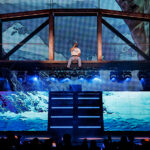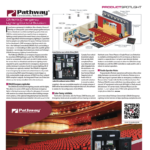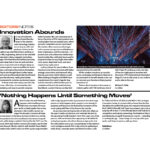
Designing A Circular Paradise
The circular structure draws all eyes, creates a dramatic presence, and contains the core of the rig of Swedish House Mafia’s production. The design debuted at the 2022 Coachella Valley Music and Arts Festival earlier this year and then underwent modifications and added automation to become the Paradise Again world tour —to promote their debut studio album of the same name across North America, U.K. and ending Nov. 13 in Europe.
SHM, known as pioneers in the electronic dance music genre, are a trio of Swedish DJs— Sebastian Ingrosso, Steve Angello and Axel “Axwell” Hedfors. In a promotional video, the band have said that “this is not a concert, it is an emotional experience. We’ve pushed the limit to put a rave into an arena.”

A Cylindrical, Monolithic Design
Ben Dalgleish and the Human Person design team are the architects of this experience. PLSN checked in with Dalgleish to find out how his out of the box thinking turned into a cylindrical form, with lighting and video from Fuse Technology Group. We also talked to the builders—All Access— to find out how they constructed the ring. And we took a look at the ER Productions laser design by Derek Abbott.
What was the starting point and design inspiration for this cylindrical look, where the lighting rig is mostly hidden in the big ring?
Ben Dalgleish: The first iteration of this show was at Coachella where Swedish House Mafia headlined Sunday night alongside The Weeknd. We brought in a large floor package that had visible lighting fixtures and while the result was impressive, it felt like a festival package. Going into the headline tour we knew we wanted to be much more careful in terms of lighting placement to make sure the whole stage felt like an architectural statement rather than a lighting showcase, and hiding the fixtures was a big part of that.
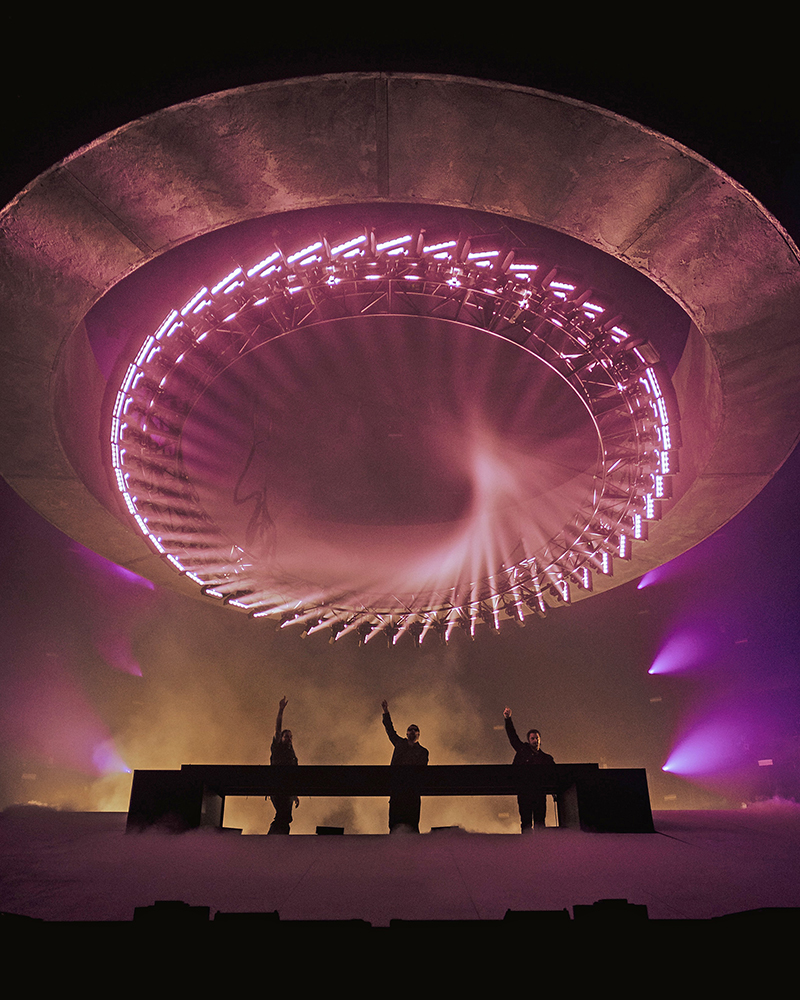
How did the large Ring come about as the centerpiece of the production?
From the moment Human Person was engaged to work on the show, we wanted to have a large monolithic structure be the center piece. We collaborated with the artist Alexander Wessely, who also serves as the band’s creative director, and the decision was made to go with a singular large ring. The circle shape has played a large part in Swedish House Mafia’s iconography since the start of their career — we wanted to take that representation to the highest possible level being that this was their first performance back since the pandemic, and their first performance with their debut album being released.
Describe the lighting rig.
We have a 30’ circle truss lined with ACME Gemini fixtures which continues the circle theme, as well as a 50’ diameter circle loaded with [Claypaky] Sharpys that encompasses the whole stage. A big part of the show is the interplay between these two lighting circles and the physical ring, with the smaller circle and the fabricated ring being on automation moving to different positions throughout the show and interacting with each other.
Let’s talk about what is new for you in the rig. Why did you choose to use the newVari-Lite VL10 BEAMWASH?
I knew I wanted to use a hybrid fixture because it was important that every light provided more than one mode—beam, wash and spot. Every fixture also had to perform double duty in what it had to light: the scenic elements; ring and sloped stage— as well as the aerial effects. We have a large number of these units behind the ring on 60’ tall truss towers, lining the side of the stage as well as the audience trusses running down the length of the arena.
The Chauvet Color STRIKE M is also new for you to use.
Being an electronic music act, having a large number of strobes was always going to be a priority. For Coachella I used a mixture of [TMB] Solaris Flare units and [GLP] JDC1 strobes as we needed the color punch of the flare with the white intensity of the JDC1. I was really surprised when testing the Color STRIKE M that the plate successfully provided the required color intensity we needed while also having even more blinding strobe power. So, we put them everywhere, all over the set, including in a grated riser beneath the band and all over the audience trusses.
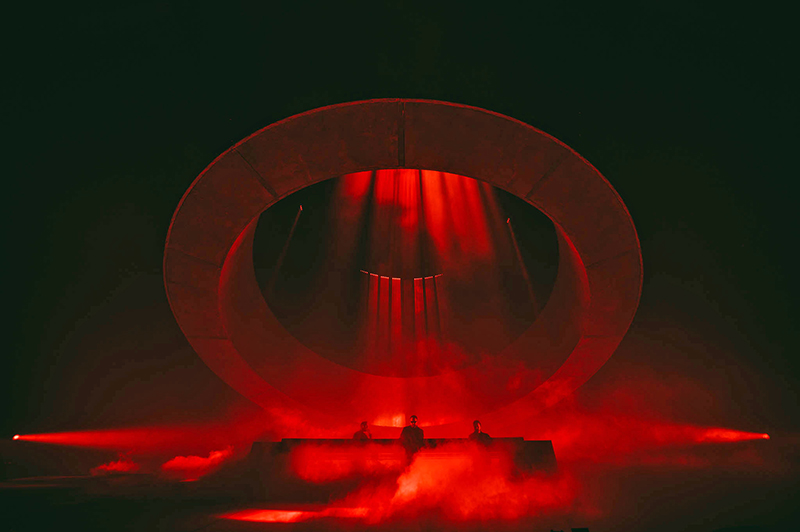
What design considerations did you take into account when considering it would go from a one-off Coachella performance to a touring production?
The biggest consideration was that for the tour there was no video content as part of the design, and lighting would need to take the forefront in every moment of the show. When designing the rig, I wanted to make sure I had lighting in positions to create the backdrop, as well as lighting the plentiful smoke and haze, the scenic element and, of course, the band themselves. Having a large sense of scale was important to the design and we were constantly pushing the limits of how high we could rig the towers in the arena. We aimed to have lights all the way to the roof.
Talk about working with All Access on the Ring construction.
The ring was constructed to come together quickly in a festival changeover, so it was a perfect fit going into the headline arena tour. Making the change to have the ring beyond automation—which it was not at Coachella— allowed for a greater variance of key stand-out moments.
What were your thoughts about not having video as a main part of the design?
We always knew doing a show without video content was going to be a challenge but knowing that it very rarely happens was an opportunity we jumped on. A ton of credit needs to go to Davey Martinez whose skill in lighting programming, creating looks with depth and intensity, was core to the success of the show. However, there is some video in the show. A large amount of I-Mag and Notch effects are created and operated in real time by Stephen Hedges. These effects highlight the band’s performance and convey their energy to the farthest seat in the house. Notch designer Ryan Sheppard helped facilitate this by giving the show a narrative arc through his Notch designs.
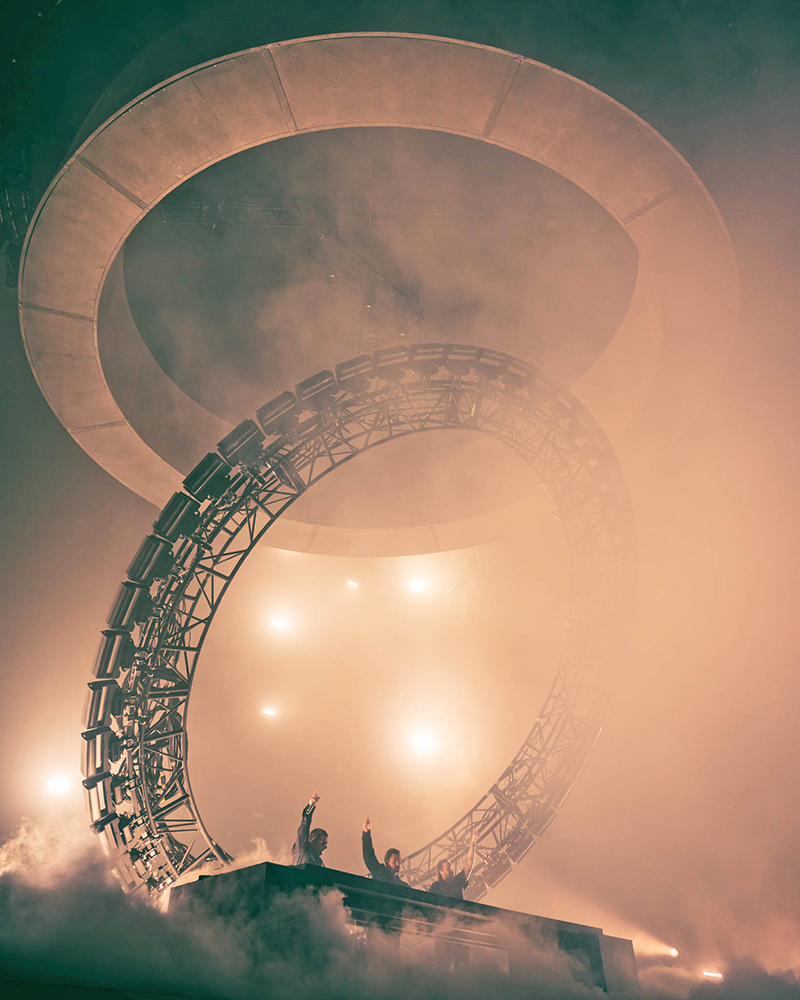
How much of a role does automation play in the show?
A big role! We wanted the show to have multiple architectural states, and automation allowed us to do that. On the technical side— automation cues are triggered manually, with Show Director Stephen Hedges sending cues visually from Resolume. It was a hard show to program due to the Concrete ring and lighting circle not having much clearance between the two. The motors normally run at 10m per minute and the fastest maneuver is around 5m a minute. The automation operator and programmer was Tommy Dewitt Jr, who did a great job translating my hand gestures into legit cues!
Talk about how the laser design came about and what you wanted to achieve by using lasers.
Laser designer Derek Abbott continued building upon his design that started at Coachella by designing a laser system that took advantage of the towers behind the ring, and units that silhouetted the three band members dramatically. One of the highlights of the show is the laser sequence in the song “One” that features the lasers perfectly synced to the intricately sound designed audio.
How was your experience working with Fuse?
There were multiple setlist changes during the start of the tour with the band adding and taking away songs to match the crowd’s energy. The Fuse lighting crew, led by Glenn Power, worked tirelessly to give time for the lighting team, including Lighting Director Brandon Wade, to program these new songs before doors opened at practically every show. Big shout out to them and legendary Production Manager Will Keating, who met every challenge with enthusiasm and efficiency!
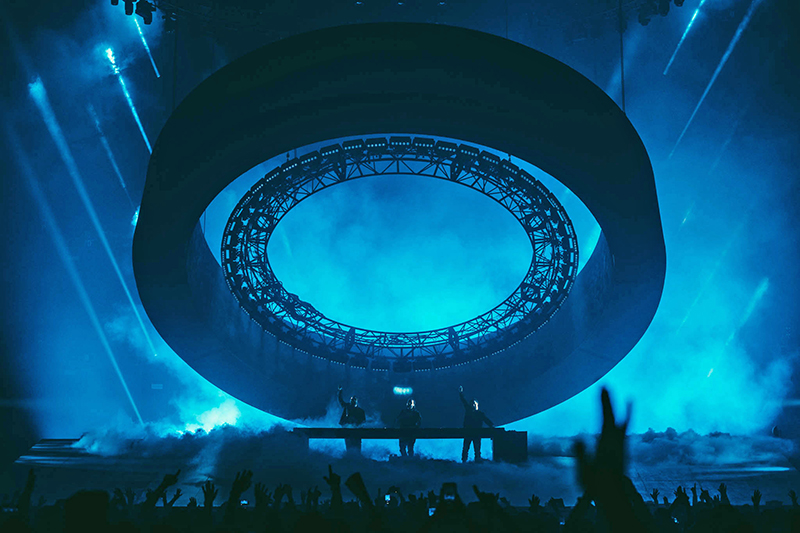
Making the Ring Access-ible
Robert Achlimbari of All Access Staging started construction on the ring in spring, crafting it in time for its Coachella debut. The design considerations were many, as at the end of the day, the crew would basically be packing a round peg—the ring—into a square hole—the truck space. Achlimbari shared some construction details.
What are the construction basics?
Robert Achlimbari: The ring is basically an aluminum frame and plywood cladding with a textured scenic finish. It weighs around 6,500 lbs. Its outside diameter is 42’ and inside diameter is 33’ with a height of 7’.
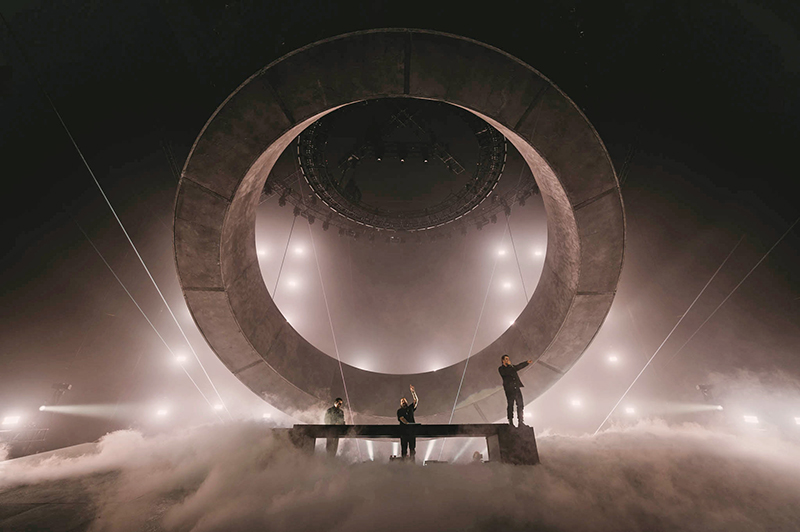
What role, if any, did you have in modifying its concept or design on paper?
I got the design concept from a basic drawing and conversations with Joe Sanchez and Will Keating. I took that concept and detail then produced a working version to prove the concept and get the first-round engineering study done. When the engineering study came back positive for the concept we moved forward with the build drawings and details for fabrication. After some back and forth we ended up making some adjustments for Coachella which was the first use of the ring. It turned out that we could not get the weight loading where we need to in the roof so rather than being flown it ended up being rigged on two motors downstage, with the upstage supported by two custom articulating carts.
How did you make it transportable by truck?
Designing this to tour made the obvious choice of building a series of curved truss-like sections impractical from a trucking perspective. I determined a flat pack system of external/ internal sides mounted to a base frame with spacers that secured the sections together and also acted as strategic rigging points. The entire ring packs on six carts approximately 11’ x 45”, each cart carrying two of the 12 segments.
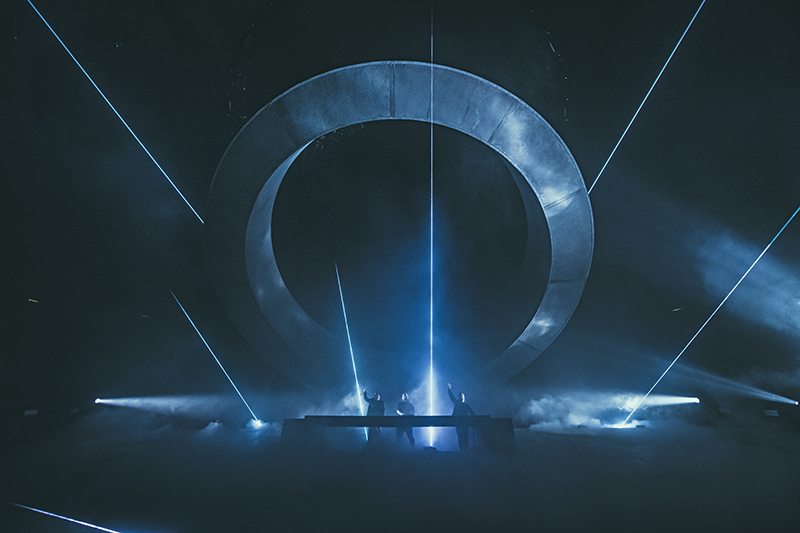
A Look at the Lasers
Laser vendor ER Productions worked with the band for Coachella as well as the tour. Laser Designer Derek Abbott collaborated with the creative team to create special moments throughout the production.
What role do lasers play in the show?
Derek Abbott: The lasers are used as a very distinct special effect for certain moments; and then used to accent lighting and highlight key track sections as well. Overall the lasers play a small but important role given their history in electronic dance music.
What laser directives were you given by the design team when the design was being discussed?
The band created a very intricate “sound design” section that they used to transition into their famous track, “One”. We used the lasers to create a highly detailed visual representation of that intro that built huge anticipation into “One.”
How did you approach the laser design on this arena production, and what effect did the big ring have on that?
As this was an arena tour, the laser design was done with that in mind. We focused on being able to make bold impactful moments that felt big inside of the large venues we were playing. We had to be careful with placement of lasers as the ring was so large, so we decided to outline the ring with emphasis being downstage. We also positioned a laser at FOH to project aerial beams back toward the stage as well as map and trace out portions of the set.
The lasers are used as a very distinct special effect for certain moments; and then used to accent lighting, and highlight key track sections as well. With the placement of the laser spread around the ring, we were able to create moments that encapsulated it, while at the same time highlighting its scale.
You were using 12 ER Productions AT-30 lasers. What’s the safety factor of these lasers when it comes to crowds, and how does that influence your programming or design?
These are high powered Class 4 lasers that need to be safely terminated above the audience. This definitely affects the design and programming as we’re limited to projecting onto only a very small area. That being said, the limitation really forces creativity!
Swedish House Mafia’s Paradise Again tour started July 29 in U.S./Canada, and runs to Nov. 13, ending in Europe.
Production Team
- Production/Lighting Designer: Ben Dalgleish/Human Person
- Stage Design/Creative Director: Alexander Wessely
- Show Director/Video Director: Stephen Hedges
- Notch Designer: Ryan Sheppard
- Lighting Programmers: David Martinez & Nicolas Van Nostrand
- Laser Designer: Derek Abbott
- Production Manager: William Keating/1826
- Tour Director: Daniel Humphreys/1826
- Stage Manager: Michael Phillip Howson/1826
- Lighting Director: Brandon Eric Wade
- Lighting Crew Chief: Glenn William Power
- Lighting Techs: Bart Lee Buckalew, Eric Merle Marshall, Paul Carson, Aaron Joseph Garcia, Deanna McIntyre
- View Crew Chief: Loic Woehrel
- Video LED Tech/Cameras: Tess Orion Wolsky
- Touring Laser Tech/Operator: Ivan Dokmanovic
- Pyro Crew Chief: Alberto Gonzalez
- Pyro Operator: Bradford Kellogg
- Pyro Techs: Andrew Patrick May, Daniel Sochacki
- Automation Rigger/Operator: Tommy Arnold Dewitt Jr.
- Lead Rigger: James Philip Ude
- Rigger: Julius William Daves Jr.
Vendors
- Lighting & Video: Fuse
- Lasers: ER Productions
- Pyro: Image SFX
- Ring Construction: All Access/xRep. Robert Achlimbari
Gear
Lighting
- 115 Vari-Lite VL10 BEAMWASH
- 112 Chauvet Color STRIKE M
- 102 ACME Gemini
- 48 Claypaky Sharpy
- 35 Robe BMFL WashBeam
- 18 GLP FR10
Video
- 2 Human Person Media Servers: Custom Built Rack Mount PC running Resolume, RTX A6000, Threadripper Pro WX 16 Core
Lasers
- 12 ER Productions AT-30
- 1 Sollinger PHAENON X AT
- Laser Software: Pangolin BEYOND, Depence Visualizer
